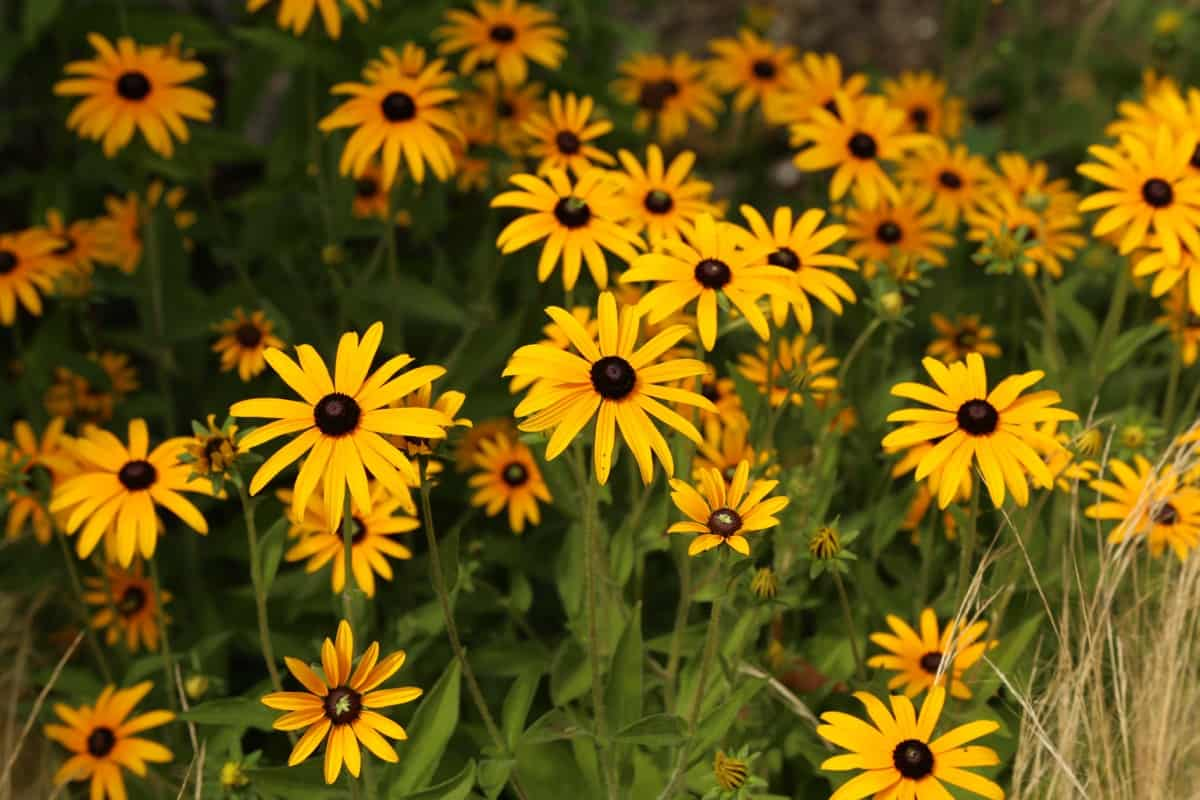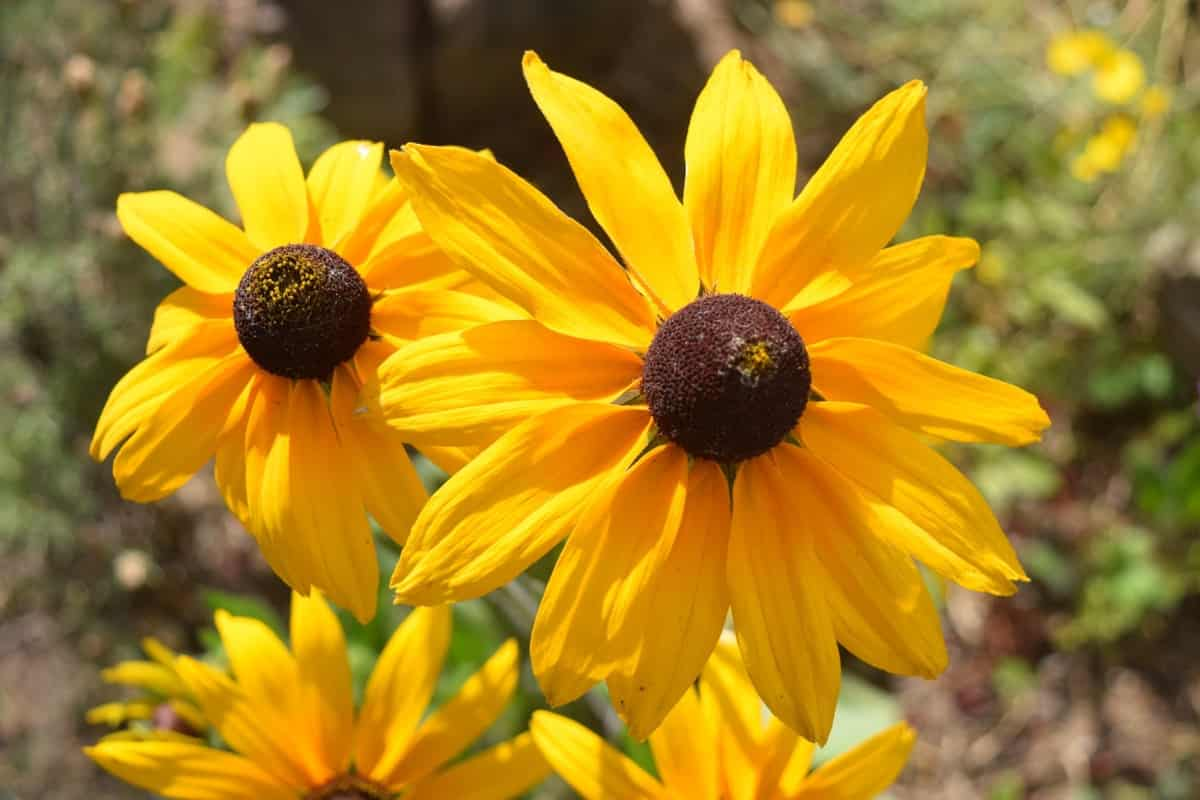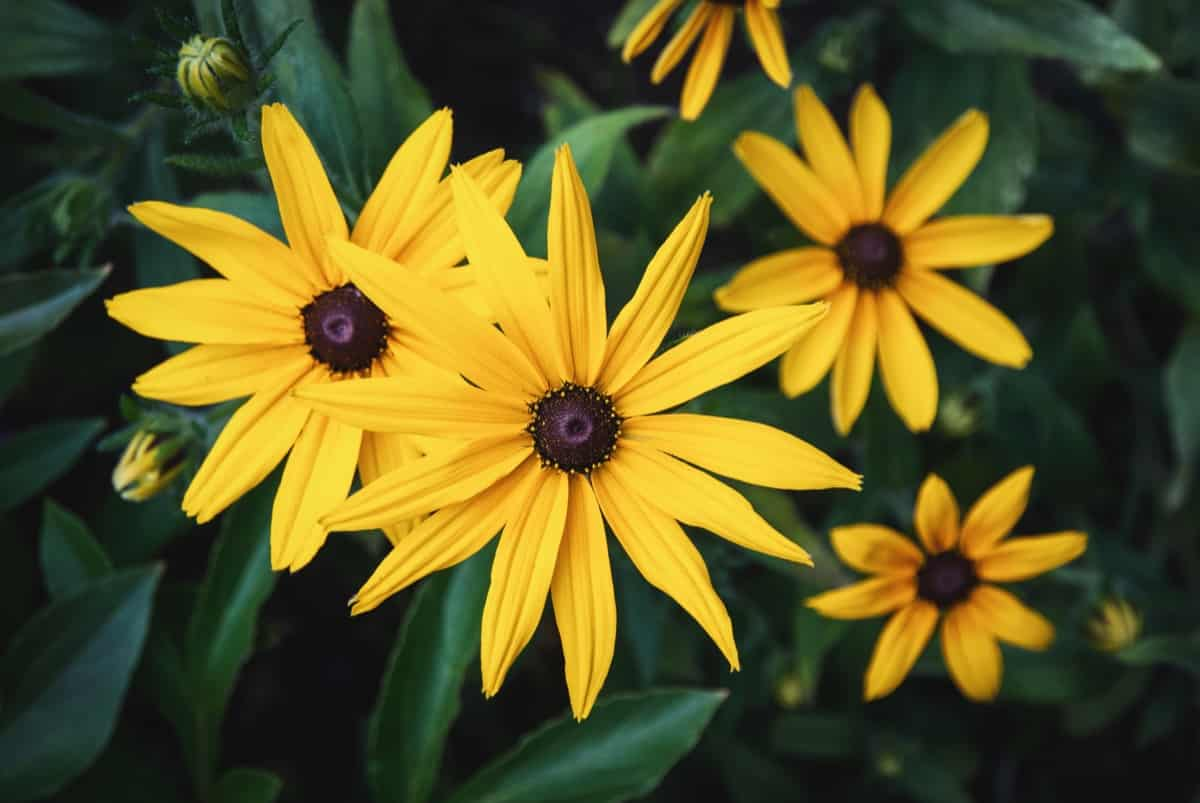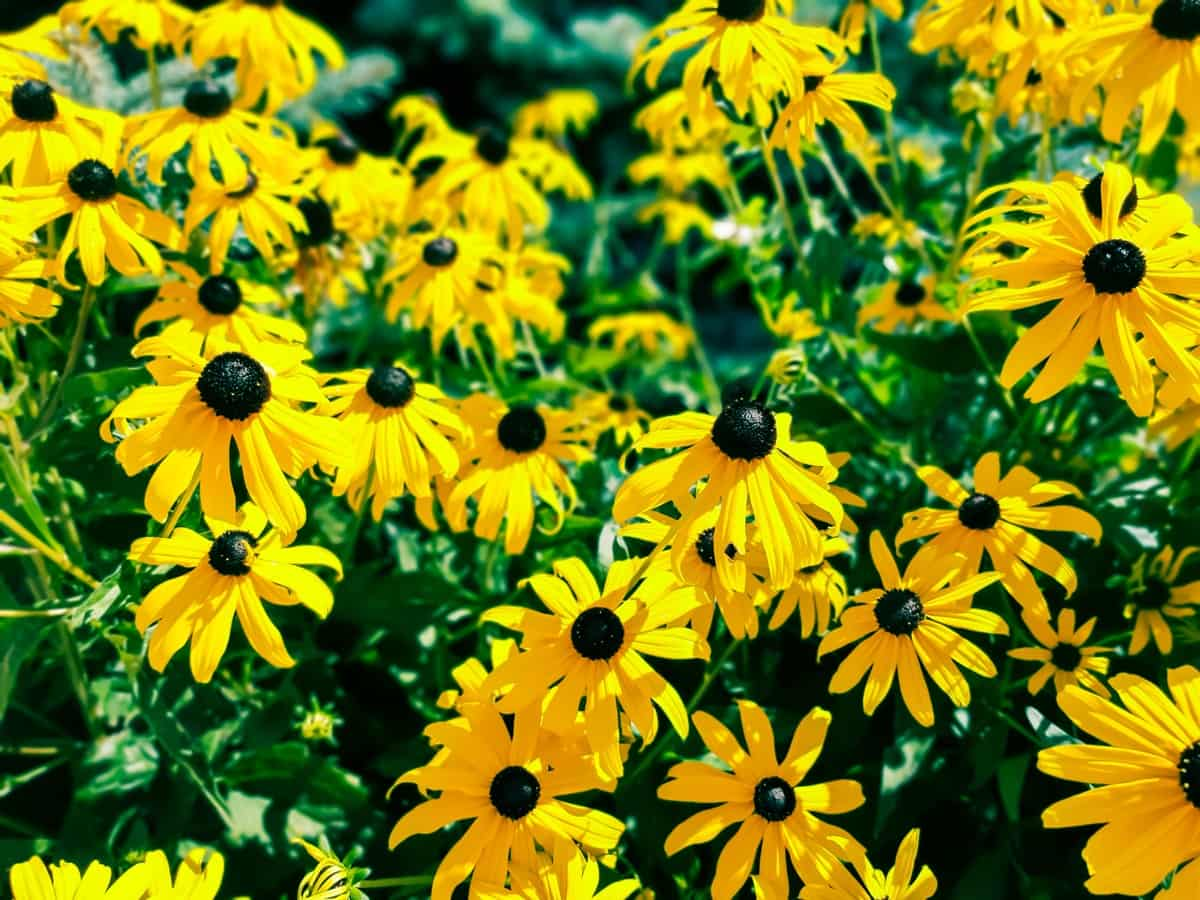A Black-Eyed Susan plant grows in clumps, producing yellow or gold ray flowers with black centers. Black-Eyed Susan plants are easy to grow and make excellent cut flowers. Black-Eyed Susan vine is a beautiful, summer-flowering annual perfect for adding color to any garden or landscape.

There are wide varieties of Black-Eyed Susan vine, so choosing the right one for your garden is important. This charming plant is popular among gardeners for its striking yellow petals with dark centers, long blooming seasons, and low maintenance care. Black-Eyed Susan plants are one of the easiest flowers to grow in the garden. They are drought-tolerant and will bloom all summer long with very little care.
How to Grow and Care for Black-eyed Susan in Your Garden
Types of Black-Eyed Susan
African Sunset
The African Sunset Black-Eyed Susan Vine is a beautiful, fast-growing vine that blooms from late spring to early summer. The flowers are a deep golden with black centers, and the leaves are dark green. This vine does well in warm climates.
Spanish Eyes
The Spanish Eyes Black-Eyed Susan vine is a beautiful, unique variety of this popular flower. The petals are a deep peach and gold color with a black center. This stunning combination makes for a striking addition to any garden or landscape. Blooms attract bees and butterflies to your yard. Spanish Eye is a fast-growing vine reaching up to 5 feet long. It’s easy to care for and is drought-tolerant once established.
Superstar Orange
Superstar Orange is a Black-Eyed Susan vine known for its beautiful orange flowers. This vine is a great addition to any garden and will provide plenty of colors all season.
In case you missed it: Custard Apple Diseases and Pests (Sugar Apple): Anthracnose, Black Canker, Diplodia Rot, Leaf Spot, Symptoms, Causes, and Prevention

Aurantiaca
Aurantiaca is a type of Black-Eyed Susan vine that produces orange-yellow flowers. It is a fast-growing vine that can reach up to 6 feet long. Aurantiaca is a popular choice for gardeners because it is easy to care for and attracts butterflies.
Climate Suitable for Growing Black-Eyed Susan in the Garden
Black-Eyed Susan plants need full sun to partial shade and well-drained soil. The plants are quite drought-tolerant once established. As for sunlight, these flowers need at least 6 hours of direct sun daily to thrive. However, they can tolerate afternoon shade, especially in hot summer climates. Deadheading the spent flowers will encourage continued blooming.
Black-Eyed Susan plants will self-seed readily, so if you don’t want them spreading throughout your garden, remove the spent flower heads before they mature. The ideal daytime temperature for growing Black-Eyed Susan is between 21 to 27°C. At night, the temperature should not drop below 16°C. If the temperature drops below 16°C, providing some form of artificial heat, such as a heat lamp, is important.
In case you missed it: How to Grow and Care for Agave in Your Garden: A Step-by-Step Beginners Guide

Soil Requirement for Growing Black-Eyed Susan in The Garden
Black-Eyed Susan plants are not picky regarding soil, but they prefer well-draining, loamy soil. If your garden is heavy or clay, consider amending it with some organic matter to help improve drainage. These plants tolerate many pH levels, so you shouldn’t be too concerned. Just ensure the soil is not waterlogged, which can lead to root rot. They will also do fine in average garden soil if it is not too heavy or clay-like. Black-Eyed Susan plants are easy to grow in most soil types as long as the soil is well-drained. Avoid wet, soggy soils that can lead to root rot.
Water Requirement for Growing Black-Eyed Susan in The Garden
Black-Eyed Susan is a warm-season annual that is commonly grown in gardens. Black-Eyed Susan is easy to grow and care for, making it a great choice for beginning gardeners. Black-Eyed Susan tolerates drought but will bloom best with regular watering. Water is essential for plant growth, and Black-Eyed Susan is no exception.
In general, they prefer well-drained soils and consistent moisture. However, they are pretty drought-tolerant once established. You should provide a few inches of water weekly through rainfall or irrigation. If you live with little rainfall, supplement with irrigation.
Propagating Black-Eyed Susan
From Stem Cuttings
Black-Eyed Susan plants are easy to propagate from stem cuttings. Take a 6-inches of stem cutting from a healthy plant in early summer and remove the bottom leaves. Dip the stem cutting in the rooting hormone and plant it in a pot. Keep the pot in indirect sunlight and keep the soil moist. The cutting should root within 4-6 weeks. Once it has rooted, you can transplant it into your garden.
In case you missed it: Best Ways to Rejuvenate Old Potting Soil

From Seed
If you’re looking for a cheerful, easy-to-grow annual for your garden, look no further than the Black-Eyed Susan. This wildflower is beautiful, drought-tolerant, and loved by pollinators. The plants grow best in well-drained soil and will tolerate some drought. Once established, they are relatively low maintenance and can even reseed themselves. To plant Black-Eyed Susan, scatter seeds on the ground in early spring or fall. You can also start them indoors 6-8 weeks before your last frost date.
Once they have germinated, thin the seedlings so that they are about 8 inches apart. When the plants are 6 inches tall, you can transplant them into garden beds or containers. You can grow Black-Eyed Susan plants from seed. You can directly scatter the seeds on the soil in early spring and lightly cover them with the soil. Keep the soil moist until germination, usually within a week or two. Once the seedlings emerge, thin them to 12-18 inches apart. Allow the plants to dry between watering to prevent powdery mildew. Fertilize monthly with a general-purpose fertilizer.
Transplanting Black-Eyed Susan Seedlings
When transplanting Black-Eyed Susan seedlings, it is important not to damage the roots. First, loosen the soil around the plant with a spade or trowel. Next, gently lift the plant from the ground, not breaking any roots. Finally, replant the seedling at the originally planned depth in a new location.
Black-Eyed Susan Plant Care
Fertilizer Requirement for Growing Black-Eyed Susan in The Garden
To ensure your Black-Eyed Susan plants have the nutrients they need to grow and bloom their best, fertilize them regularly throughout the growing season. A general-purpose fertilizer applied monthly is all that’s needed. You should follow the instructions on the fertilizer package so you don’t apply too much, which can damage the plants. Black-Eyed Susan plants are not particularly fussy regarding fertilizer, but they benefit from a little extra boost in the spring.
In case you missed it: Best Ways to Prevent Pesky Slugs and Snails in Your Garden Plants

A general-purpose fertilizer will do the trick, but if you want to give your plants something extra, consider using a fertilizer specifically designed for flowering plants. Manure is one of the best garden fertilizers for growing Black-Eyed Susan. Manure will help add nutrients to the soil necessary for the plant to grow. Another good fertilizer to use is compost. Compost will also help to add nutrients to the soil, and it will also help to keep the soil moist.
Pruning Black-Eyed Susan Plants
Pruning Black-Eyed Susan plants is an important part of their care. The perfect time to prune them is in the late winter or early spring before they grow new leaves. Be sure to prune any dead or damaged stems first. Black-Eyed Susan plants don’t require a lot of pruning. To encourage bushier growth, you can prune them back by a third in late spring or early summer. Cut the stems just above a set of leaves. To keep the plants from getting too big, cut them back hard in early spring before new growth begins.
You’ll need to do deadheading to keep your Black-Eyed Susan plants blooming all season. This means removing the spent flowers before they turn into seed heads. You can either snap the flower heads off with your fingers or use garden shears. Cut the stem down to the next leaf node to encourage new growth. Cut back any dead or damaged stems and thin out crowded areas. This will help improve air circulation and prevent fungal diseases.
Black-Eyed Susan Plant Care in Winter
When the weather turns cold, many gardeners wonder how they can best take care of their Black-Eyed Susan plants. The essential thing you can do for your Black-Eyed Susan plants is to give them good pruning. This will help them to stay compact and prevent them from getting leggy. You can prune your plants back by about one-third of their total height. It’s also important to ensure your plants get enough water.
In case you missed it: How to Make Biodegradable Peat Moss Planters and Pots: For Your Garden Plants

During the winter, the ground is typically much drier than it is during the growing season. Make sure to water your plants deeply and evenly, not overwater them. You may consider covering your plants with mulch if you live in an area with particularly harsh winters. This will help protect their roots from the cold and keep them from drying out. A layer of straw or leaves around the base of each plant should be sufficient.
Pests and Diseases of Black-Eyed Susan and their Control
A few pests can affect Black-Eyed Susan plants in the garden, but luckily there are also some easy ways to control them. Aphids are soft-bodied insects that feed on plant sap. They can cause stunted growth and distorted leaves. To control aphids, use an insecticidal soap or neem oil. Japanese beetles are another common pest of the Black-Eyed Susan plant. These shiny, metallic-green beetles skeletonize leaves as they feed. Handpick them off plants and drop them into soapy water to kill them. You can also use traps specifically for Japanese beetles.
Black-Eyed Susan plants are relatively resistant to diseases, but a few can affect them. The most common is powdery mildew, which appears as white or grayish-white powder on the leaves and stems. It can cause the leaves to curl up and eventually drop off. To control it, water in the morning. If powdery mildew is severe, you can use a fungicide designed for it.
Another disease that can affect Black-Eyed Susan plants is rust. This fungal disease causes orange or brown spots on the leaves, which eventually turn black and fall off. To control rust, water in the morning so the foliage has time to dry out during the day. You can also remove and dispose of infected leaves, so they don’t spread the disease further. If rust is severe, you may need to use a fungicide designed for it.
In case you missed it: How to Grow and Care for Forsythia in Your Garden: A Step-By-Step Guide for Beginners

Conclusion
Black-Eyed Susan plants are the most popular flowers in the garden. The flowers are usually yellow or orange, with a black center that resembles a black eye. The plants can bloom from late spring to early fall. Black-Eyed Susan is a beautiful flower that can bring life to any garden. With its bright yellow petals and signature black center, it’s sure to be a showstopper in your landscape. These easy tips on growing and caring for Black-Eyed Susan will ensure you have healthy plants all summer.
- Gongura Seed Germination and Planting Methods
- Cabbage Seed Germination and Selection
- Broccoli Seed Germination and Selection
- Asparagus Seed Germination and Variety Selection
- Seasonal Flower Gardening: Best Practices for Spring, Summer, Fall, and Winter
- How to Grow Hibiscus from Flower
- Plantation Ideas for Home Decoration: A Beginners Guide
- Flower Garden Designs and Layouts for Beginners
- Planting and Spacing Techniques in Papaya: A Beginner’s Guide
- Growing Gold: Essential Techniques for Planting Pineapples
- How to Make Kalanchoe Plant Bushy: Home Remedies and Solutions
- 11 Reasons Why Your Gardenia is Not Blooming: Home Remedies and Solutions
- Eco Elegance: The Guide to Designing a Drought-Tolerant Landscape
- Gardening on a Slope: Strategies for Hillside Landscaping
- Nourish and Flourish: Top Organic Mulches for Thriving House Plants
- Everything You Want to Know about Indian Mogra Flower: Discover Uses and Growing
- Green Thumb Success: Expert Tips for Cultivating Greenhouse Pumpkins All Year Round
- Maximize Growth & Flavor: The Ultimate Guide to Companion Planting in Herb Gardens
- How to Control Rhododendron Problems Naturally: Home Remedies and Organic Ways to Fix Them
- Natural Magic: The Remarkable Benefits of Cinnamon for Plants
- Best Steps to Revive Dying Tulip with Natural and Organic Treatment
- 10 Reasons Why Your Angel Trumpet is Not Blooming: Remedies and Treatment
- How to Fix Periwinkle Leaf and Flower-Related Problems: Natural Remedies and Solutions
- How to Fix Zinnias Leaf and Flower Problems: Discover Natural and Home Remedies
- Organic Steps to Induce Lemon Tree Flowers: A Comprehensive Guide
- Bloom Booster: Crafting the Perfect Homemade Bougainvillea Fertilizer
- Optimizing Growth: A Guide to Applying NPK Fertilizer for Potted Plants
- 10 Best Homemade Fertilizers for Rubber Plant: DIY Recipes and Application Method
- How to Boost Female Pumpkin Flowers: Effective Steps for More Flowers and High Yields
- Transform Your Indoor Garden: Top Benefits of Pink Salt for Houseplants
- 10 Best Homemade Fertilizers for Peacock Plants (Calathea): Easy DIY Guide
- Unlock Blooms: 9 Reasons Why Your Potted Chrysanthemum is Not Blooming
- 8 Reasons Why Your Potted Hibiscus is Not Blooming: Fix it with Simple Solutions
- Unlock Blooms: 9 Key Reasons Your Potted Frangipani Won’t Flower
- 10 Reasons Why Is My Ice Plant Not Blooming: Remedies and Treatment
- 10 Reasons Why My Potted Hydrangea Not Blooming: Treatment and Remedies